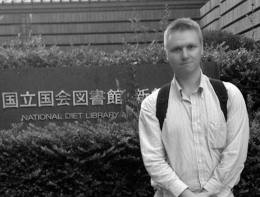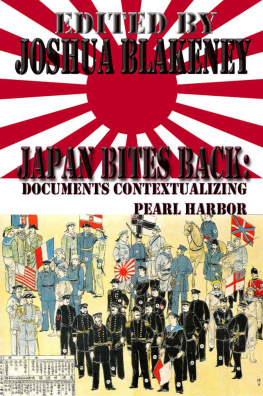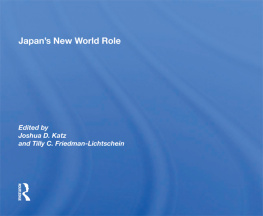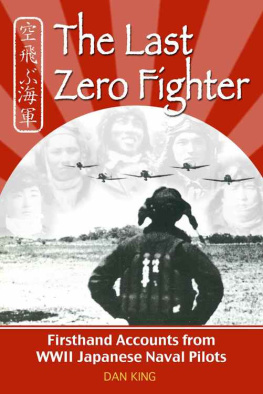JAPAN BITES BACK: DOCUMENTS CONTEXTUALIZING PEARL HARBOR
Edited By
Joshua Blakeney
JAPAN BITES BACK: DOCUMENTS CONTEXTUALIZING PEARL HARBOR
Copyright 2015 Joshua Blakeney
All Rights Reserved.
ISBN-13: 978-1507785614
ISBN-10: 1507785615

www.nonalignedmedia.com
All photos/images are public domain unless specified otherwise.

Joshua Blakeney, pictured here at the National Diet Library in Tokyo, is a journalist, radio-host and pundit based in Alberta, Canada. He has been Press TV's Canadian correspondent since 2012. He is co-founder of Non-Aligned Media. His email address is: josh.vivelarevolucion@gmail.com
TABLE OF CONTENTS
INTRODUCTION Joshua Blakeney
1. THE SINO-JAPANESE CONFLICT: A SHORT SURVEY The Foreign Affairs Association of Japan
2. THE BOLSHEVIZATION OF CHINA Hikomatsu Kamikawa
3. THE AMERICAN POSITION : CATS-PAW OR COMMON SENSE Ujiro Ohyama
4. JAPANS CONTINENTAL POLICY Katsuji Inahara
5. TOTALITARIANISM VERSUS DEMOCRACY Kojiro Sugimori
6. THE ANGLO-AMERICAN COMMON FRONT Kumataro Honda
7. THE THREE POWER PACT Nobumasa Suytsugu
8. GENESIS OF THE PACIFIC WAR Kohsaku Tamura
INTRODUCTION
Joshua Blakeney
The War on Truth
The publications contained in this book are particularly rare and the powers-that-be hoped that they would never reach the eyes of you, the reading public. In September 1945, just one month after the U.S. had dropped atomic bombs on the people of Hiroshima and Nagasaki, killing approximately a quarter of a million people in the process, The Civil Censorship Detachment (CCD) of the newly installed General Headquarters (GHQ) began a process described by scholar Nishio Kanji as book burning. 7,769 publications were identified by the CCD for confiscation, most of which favourably explained Japans prior actions or critically questioned those of the Allied forces.
In order to begin their process of psychological warfare against the vanquished people of Japan, the GHQ would have to remove all evidence of Imperial Japan having ever been involved in good things while promoting narratives, irrespective of historical facts, which depicted the ousted Japanese Government as having been solely a fountain of bad things. This demonological process encountered a hitch early on when Justice Radhabinod Pal expatiated his dissentient verdict at the International Military Tribunal for the Far East which had been convened on April 29, 1946 to prosecute much of the deposed Japanese leadership. Pal, a subject of the British-ruled Indian subcontinent, adjudged that Tokyos actions during the War did not constitute a war crime and rebuffed many of the hypocritical allegations levelled at the dislodged Japanese Government. He exposed the principle of victors justice inherent to the Tribunal, with a burst of clarity and justice that the German equivalents of those on trial in Tokyo would not receive. Thus, in a sense, the color lines that Pan-Asianism emphasized were acted out in an ironic way on the benches of the Tokyo Tribunal writes Cemil Aydin.
Pan-Asianists, such as Shmei kawa , the prominent intellectual prosecuted during the Tokyo Trials, believed that Japan as the most developed nation in Asia had had an obligation to lead regional anti-colonial forces to liberation from Western and Communist colonialism. He and his colleagues proposed the construction of the Greater East Asia Co-Prosperity Sphere, an organic amalgam of peoples, goods and services which would allow nations such as Indonesia, Burma, India, Korea, Taiwan, China, Malaysia, Philippines and Vietnam to develop symbiotically and without the depredations of colonialism.
The proponents of this Asiatic regionalism were not initially universally liked in Japan. Throughout the 1920s Pan-Asianism was in fact a marginal and negligible tendency. However, by the early 1930s its precepts had become governmental policy. The pro-British, liberalist Japanese establishment of the 1920s clung to the hope that Japan would be afforded a seat at the table of Imperialism by a process of accretion. Multilateralism was embraced and those, such as kawa , who proposed that Japan operate outside the parameters of the (Western-dominated) League of Nations and without regard for the Wests aspirations in Asia, were deemed dangerously idealistic. In this vein, the 1926 Pan-Asiatic Conference in Nagasaki was widely ridiculed by literati and the chattering classes as fanciful and divorced from political reality. From 1926 to 1943, the year when the Japanese Government itself hosted the Greater East Asia Conference, something unprecedented arose. The realists within Japan, who had in 1926 firmly supported Liberal Internationalist palliatives to Japans predicaments, metamorphosed into Pan-Asianists, coming to terms with the inevitability of what Gerald Horne has described as a race war
The scholarship of this radical shift in policy bifurcates into two main groupings; explanations which focus upon domestic political convulsions and those which emphasize the international context. Frederick Dickenson has aptly dealt with the epochal domestic factionalism which existed between the pro-liberal, pro-British elements of the Japanese establishment and the Germanicist, Pan-Asianist, illiberal elements, the latter of whom would come to the fore in Japanese politics from 1933 when Japan withdrew from the League of Nations in the wake of the Lytton Report which delegitimized Japanese operations i n Manchoukuo.
The documents in the book before you do not emphasize domestic variables as much as geopolitical ones. This, in short, is because the preponderance of evidence suggests that international developments impinged more greatly upon Japans actions by compelling Liberal Internationalists to realize the fruitlessness of their treaty-based approach to international relations relative to Imperial Powers which broke treaties and stabbed nations such as Japan in the back. In his essay Totalitarianism versus Democracy, contained in this book, Kojio Sugimori observed the intranational relationships of the past are becoming less important than the international relationships among countries. Of course when viewing the clash of civilizations that was World War II in Asia within a more prolonged historical context, it was the global supremacy of the West (i.e. external factors) which spawned the Meiji Restoration of 1868 and the process of modernization which led Japan to emerge as a regional hegemon. This further justifies an emphasis on supranational developments.
It is the politically-motivated distortion of contemporaneous geopolitical happenings and the lopsided allotment of blame for Greater East Asia War which this collection of essays intends to undermine. Typically Western accounts, especially those emanating from popular media sources in the U.S., begin the historical narrative on December 7, 1941 when Japanese planes appeared, as if out of nowhere, and attacked naval targets in Hawaii. The Opium Wars, the imposition of unequal treaties upon Japan by Commodore Perry and subsequent U.S. diplomats, U.S. naval expansion in the Pacific, the funneling of arms to the dictatorial Chiang Kai-shek regime, the Soviet, and by extension, International Zionist meddling in Asia, the Franklin D. Roosevelt Administrations provocations against Japan and many other seminal historical occurrences are concealed from Western audiences, obviating the necessary contextualization of Nippons counter-hegemonic activities as expressed in the Pearl Harbor operation.
Next page












